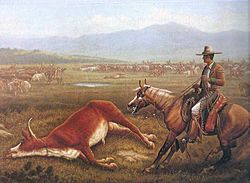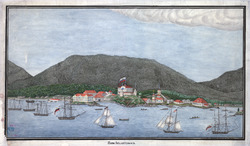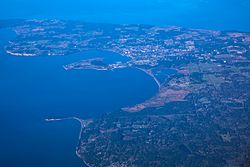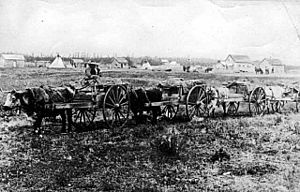Pugets Sound Agricultural Company facts for kids
The Puget Sound Agricultural Company (PSAC) was a special farming company. It was started in 1840 by the Hudson's Bay Company (HBC). The HBC was a big fur trading company. The PSAC's farms were in the Pacific Northwest, in what is now Washington state.
The HBC made the PSAC because its main business was fur trading. The British government only allowed the HBC to trade furs. So, the PSAC was created to grow food and raise animals. This way, the HBC could sell food to the Russian-American Company in Russian America (now Alaska). This deal helped the British keep American traders out of the Russian markets.
The British also hoped the PSAC would help them claim more land in the Oregon boundary dispute with the United States. They wanted the border to be the Columbia River, not the 49th parallel. This would give Britain control of most of modern Washington state, including the important Puget Sound. The PSAC tried to get British people to settle there, but it didn't work very well.
The main farms were at Fort Nisqually and Cowlitz Farm in Washington state. Fort Nisqually focused on animals like sheep for wool and cattle for meat and cheese. Cowlitz Farm was the main place for growing crops. The company also had large farms near Fort Victoria on Vancouver Island.
Contents
Why the Company Started
The leaders of the Hudson's Bay Company often talked with the British government. This helped them know what the government planned for the Oregon boundary dispute. The British wanted to claim all land north of the Columbia River. This is why Fort Vancouver was built on the north side of the Columbia River.
In 1829, George Simpson, a leader of the HBC, thought the area around Fort Vancouver was good for farming. He tried to sell food to the Russian-American Company in Alaska. But the Russians didn't accept his offer at first. Still, Simpson believed it was a good idea. He thought if the HBC supplied the Russians, American traders would leave the fur trade.
Early Farming Ideas

John McLoughlin, another HBC leader, was inspired by the cattle trade in Alta California. In 1832, he suggested that HBC workers should start a new company. This company would buy cattle from California. He called it "The Oragon Beef & Tallow Company." He thought they could sell beef, hides, and other products to England and other places. McLoughlin believed they could have over 5,000 cattle by 1842. He also found good places for the animals, like the Willamette Valley, Cowlitz, and Columbia valleys.
But the HBC leaders didn't like McLoughlin's idea. They worried that if the new company did well, HBC employees would leave the fur trade to become farmers. Simpson liked the idea of growing lots of food and raising animals. But he wanted the HBC to control it directly, not have independent companies do it. So, in 1834, the HBC decided to find a new main location for its Pacific Coast operations.
How the PSAC Was Created
The HBC's special trading license was going to end in 1841. John Pelly, the Governor of the Hudson's Bay Company, told the British government how much the HBC helped the British Empire. In 1837, he talked about the idea of farming and raising animals in the Columbia Department. He said this would keep "British interests and British influence" strong in the Pacific. Pelly's efforts worked, and the HBC got a new license in 1838. This license still only allowed fur trading, not commercial farming.
In 1838, HBC leaders like George Simpson, John McLoughlin, and Governor John Pelly met in London. They talked about the future of their business in the Pacific Northwest. Some thought that Americans might try to take land in the Oregon Question.
The Deal with Russia

The company also decided to try again to get a supply contract with the Russian-American Company. This was something Simpson had wanted for ten years. In 1839, they signed the RAC-HBC Agreement. This deal made the HBC responsible for supplying food to the Russian trading posts in Alaska.
After getting this important agreement, the HBC officially started the Puget Sound Agricultural Company in 1840. The PSAC was created to get around the HBC's fur trade-only license. It was run by HBC employees. This way, the HBC leaders and owners would not get into trouble for breaking their rules. Besides supplying the Russians, the PSAC was meant to help Britain claim land in the Pacific Northwest. This land was north of the Columbia River, in what is now Washington state. The PSAC had two main farms there: Fort Nisqually and Cowlitz Farm.
Finding Workers
Starting in 1829, many French-Canadian HBC workers became farmers in the Willamette Valley. They sold their crops to the HBC. The HBC leaders hoped these farmers would move to areas north of the Columbia River. But the farmers didn't want to leave the Willamette Valley.
The HBC still wanted to find settlers. They planned to send families from Scotland by 1841. Each family would get a house and about 100 acres of cleared land. They would also get animals like cows, sheep, oxen, and horses, plus a year's supply of food. But the families wouldn't own the land. Because of this, and because the company didn't advertise, no Scottish families came.
Red River Settlers
The only settlers who came early on were from the Red River Colony. In 1839, George Simpson told Duncan Finlayson to tell people about the PSAC. The company wanted at least fifteen families to come to Cowlitz Farm each year. Many people liked the idea, but they didn't like that they couldn't own the land.
Finlayson was under pressure to find settlers. So, without permission, he told the farmers they *could* buy the land. But there was a big catch: they could only buy it if the Oregon border dispute was settled with Britain getting the land north of the Columbia River.
Journey to Fort Vancouver
James Sinclair led 23 families, about 121 people, from Fort Garry in June 1841. Most of these settlers were Métis. They traveled north along the Red River, crossed Lake Winnipeg, and followed the Saskatchewan River to Fort Edmonton. A chief named Maskepetoon guided them.
George Simpson met the group on his trip around the world. He wrote in his diary that each family had "two or three carts, together with bands of horses, cattle and dogs." He said the settlers were "healthy and happy" and enjoyed the journey.
They traveled through Lake Minnewanka and crossed the Rocky Mountains through a new route called Whiteman's Pass. They eventually reached Fort Colvile. When they arrived at Fort Vancouver, there were 21 families, totaling 116 people.
Time with the PSAC
The Red River families didn't stay as planned. Fourteen families went to Fort Nisqually, and seven went to Fort Cowlitz. But within two years, all the families at Fort Nisqually had left for the Willamette Valley. Many of these men owed money to the HBC. In 1845, some of them told John McLoughlin they didn't want to pay back the money. McLoughlin was leaving the HBC, so he didn't push the issue.
Company Operations
In its early years, the PSAC sometimes had to buy wheat from other places to meet the Russian demands. In 1840, John McLoughlin bought 4,000 bushels of wheat from Alta California. Each year in the 1840s, the company sent 30,000 pounds of beef and 40,000 to 80,000 pounds of wheat to New Archangel. The Russian Governor, Arvid Adolf Etholén, said the PSAC's wheat was "incomparably cheaper" and "of the best quality."
Even with this success, John McLoughlin didn't think the PSAC was a good idea for the HBC. He wrote that while individuals might make a living raising cattle, the Hudson's Bay Company itself "will make nothing by it."
The Oregon Treaty
The Oregon Treaty was signed by Great Britain and the United States in July 1846. This treaty settled the Oregon Question.
The treaty had special rules for the Puget Sound Agricultural Company. It said that the United States would respect the PSAC's property. But it also said the United States had the right to buy any of those properties.
Later Years
In 1863, Great Britain and the United States agreed to decide what would happen to the PSAC's properties in the U.S. In 1869, the PSAC was paid $200,000 for all its properties south of the Canadian-U.S. border, as stated in the Oregon Treaty.
After this, the company's farming work moved north to Vancouver Island. In 1934, the Puget Sound Agricultural Company was no longer listed on the stock exchange.
|





